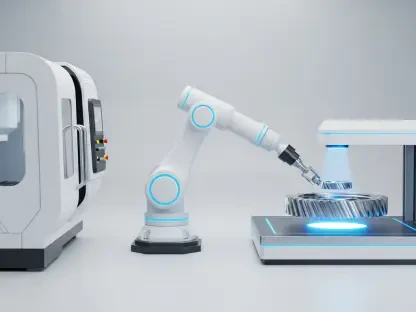The production line has always been the backbone of the economy. Thanks to the latest innovations, shifts in consumers’ preferences, and consideration of the planet’s well-being in the 21st century, this sector is experiencing a new expansion. This article analyses trends that defined the manufacturing industry in 2024 and will continue to reshape our lives as we step deeper into the 21st century.
Technological Innovations
Industry 4.0
Also known as the Fourth Industrial Revolution (4IR), is defined by the use of data, connections, analysis, people, and robots in production. This process began in the mid-2010s when cyber-physical systems were explicitly introduced to improve the productivity of the value chain.
Key Technologies:
Connectivity: Cloud tech, IoT, blockchain.
Analytics: AI, machine learning.
Human-Machine Interaction: Robotics, AR/VR.
Advanced Engineering: 3D printing, renewable energy.
Employee engagement became very significant in the entire transformation process. This promotes training to ensure a person fits into the new shift in their working position. Only in the next stage should the company promote and reward competitiveness, teamwork, and acknowledgment. The Global Lighthouse Network seeks to uncover manufacturing facilities using 4IR technologies and set them as examples for other production facilities.
Economic Impact:
Early adopters of Industry 4.0 can see a 122% positive significant cash flow increase.
Slower adopters may face downturns. Businesses that use AI can expect their profits to increase by 10 percent, while those that ignore AI may see a 23 percent decrease in profits.
*Sources: McKinsey Global Institute, 2018
In general, Industry 4.0 is a good prospect for enhanced efficiency and improved sustainability in multiple sectors, with manufacturing, transportation, and retail among the key beneficiaries.
Automation and Robotics
Automation and robotics are the new order in production. Routine processes are increasingly being inconvenienced in automated systems to enhance efficiency and reduce human error. Based on the integral cooperation with human operators, cobots increase safety and flexibility in factories. This tendency is characteristic of such businesses as automotive and electronics, where accuracy along with velocity is crucial.
Additive Manufacturing
One of the most disruptive technologies witnessed in the design and production of products is additive manufacturing, otherwise known as 3D printing. At the same time, this technology allows the creation of prototypes and custom-made products at a high speed while minimizing the use of materials. Extending their usage in complex designs that traditional manufacturing cannot support, industries tap into the trends of customization and make-to-order.
Key Trends in 2024
1. Rise of Smart Factories
A smart factory is an integrated network of devices, communication, and computing to create a value-added assembly system, artificial intelligence, and machine learning. It is a component of Industry 4.0 and is significant for assisting manufacturing corporations in their digital transformation. Smart factories are designed for different kinds of problems, including those stemming from the COVID-19 crisis and the growing consumer expectation for faster delivery, the so-called ‘Amazon Effect.’
Contemporary factories leverage people, machines, and big data to learn and optimize processes independently. These make some processes more efficient and reduce dependence on international partners through on-demand solutions. Adopting smart factory technologies entails increased efficiency, quality, and sustainable production while enhancing the company’s strategic outlook within a growing, diverse market platform.
2. Sustainability and Carbon Neutrality
Sustainability is no longer something that companies choose to demonstrate but a new requirement that has to be met. Environmental and Social Governance (ESG) features have begun to dominate the market. Thus, manufacturers provide sustainable production to meet the increasing legal and environmental standards as well as the demands of the green population. This ranges from the goals of achieving carbon neutrality, reducing waste, using renewable resources, etc.
3. Adoption of AI and Virtual Processes
Artificial Intelligence, Digital Twins, Augmented Reality, and similar technologies are revolutionizing the manufacturing floor. Many of these advances also apply to outside monitoring and virtual service, reducing the presence of personnel at the site and promoting security. The idea of ‘dark factories’ – basically working environments that are almost completely personnel-free and run solely on robotic control, is quite an example in this regard.
4. Data-Driven Maintenance
The implementation of IoT devices is creating the foundation of data-led maintenance approaches. Real-time data-driven predictive maintenance is bringing new levels of productivity based on reducing unscheduled time. This is in line with a progressive improvement of technological infrastructure for heavy data analysis, especially with the deployment of 5G networks.
5. Supply Chain Reassessment
The effects of COVID-19 led to a greater focus on domestic manufacturing due to the trade war between the US and China. This exposed weaknesses in the supply chain, leading most manufacturers to make changes. Now, companies feel pressure to produce more goods locally and reduce reliance on risky suppliers. To do this, they need to assess supply chain risks, diversify their sources, and keep extra inventory as a safety net. Firms must also carefully evaluate and categorize suppliers to accurately assess risks and create backup plans such as the ‘China plus one’ strategy. Additionally, improving process innovation, like automation and 3D printing, can enhance efficiency. Lastly, companies must find a balance between cutting costs and ensuring a resilient supply chain once the pandemic is over.
6. Shift from B2B to B2C
Moving from traditional B2B practices to a B2C model is a big change for manufacturers. Manufacturers need to adapt to changes in customer expectations and digital technology. To do this, they should focus on getting closer to their customers and overcoming barriers like organizational culture and technology adoption. This means paying attention to customer behaviors to stay relevant. By doing so, they can increase revenue, improve customer interaction, and provide a personalized approach to each customer. To remain competitive in a constantly changing market, manufacturers should implement the D2C model and incorporate all available selling techniques into their strategy.
7. Reshoring as a Standard Practice
A few years ago, managers talked about bringing production facilities back to the domestic market to improve quality, service, and speed. However, in recent years, reshoring has become more important. In 2024, reshoring is considered a good solution for supply chain management due to increased transportation times, rather than just a quick fix for a temporary issue. It has actually become more widely adopted as a standard way of conducting business activities.
8. Enhanced Employee Safety and Health
Improving health and safety in the manufacturing industry is essential and can be achieved through four key steps. First, creating a culture that prioritizes health and safety involves engaging employees, simplifying procedures, rewarding positive behaviors, and maintaining open communication with management.
Second, proper safety tools go beyond personal protective equipment (PPE) to include comprehensive health and safety systems, policies, and practices. Third, adequate safety training is crucial due to the inherent risks in manufacturing; this includes tracking completed training and offering easy access to resources, potentially through a health and safety training app.
Finally, integrating a detailed health and safety program allows employers to monitor and evaluate all safety measures effectively, often aided by manufacturing environmental health and safety (EHS) software. A robust health and safety system not only protects employees working with hazardous materials and machinery but also enhances productivity, quality, and employee morale while minimizing costs associated with incidents.
9. Advances in 3D Printing
3D printing technology has evolved from a niche concept to a vital assembly tool across industries such as aerospace, healthcare, automotive, and fashion. Among new materials for making complex parts, we speak about strong, self-healing polymers and metal. In healthcare, they are either replacing treatments or helping the tissues regenerate, and they are also enhancing drug delivery systems.
The programs produced for designing software and desktop printers have helped many people gain access to creative products and get into business. This sector is also scoping ways of adding value, such as recycling and using renewable forms of energy in the processing. The study on biodegradable products is also assisting the environmentally friendly initiative for sustainable development. In total, these innovations are revolutionary for manufacturing as they are creating the potential for new, more individualized, efficient, and sustainable production techniques.
10. Addressing Labor Force Challenges
The demand for manufactured products is increasing, and businesses need to be more flexible and productive to keep up. Therefore, evaluating processes to find better ways of working and providing staff with the support they need will become an increasingly important trend. Universities also need to ensure that students receive the technical training required by the current job market. Some trends are similar to previous years, while others are specifically developed to address modern challenges.
Challenges Facing the Manufacturing Sector
While the industry is poised for significant advancements, several challenges remain:
Supply Chain Disruptions: The pandemic showed that manufacturers needed to find more suppliers and use local sources more. This would help them be stronger in the face of challenges.
Workforce Development: The move to more advanced technologies requires a skilled workforce, leading to a gap in skills. To address this, manufacturers are investing in training and forming partnerships with educational institutions to prepare workers for future roles.
Conclusion
The global production line is at a critical point. It needs to embrace new technology and prioritize sustainability. By recognizing these trends and addressing these challenges, manufacturers can uncover new opportunities and efficiencies. This will enhance competitiveness and promote responsible resource use and investment in human capital. Looking ahead, success will depend on staying updated and adaptable to ongoing changes.









